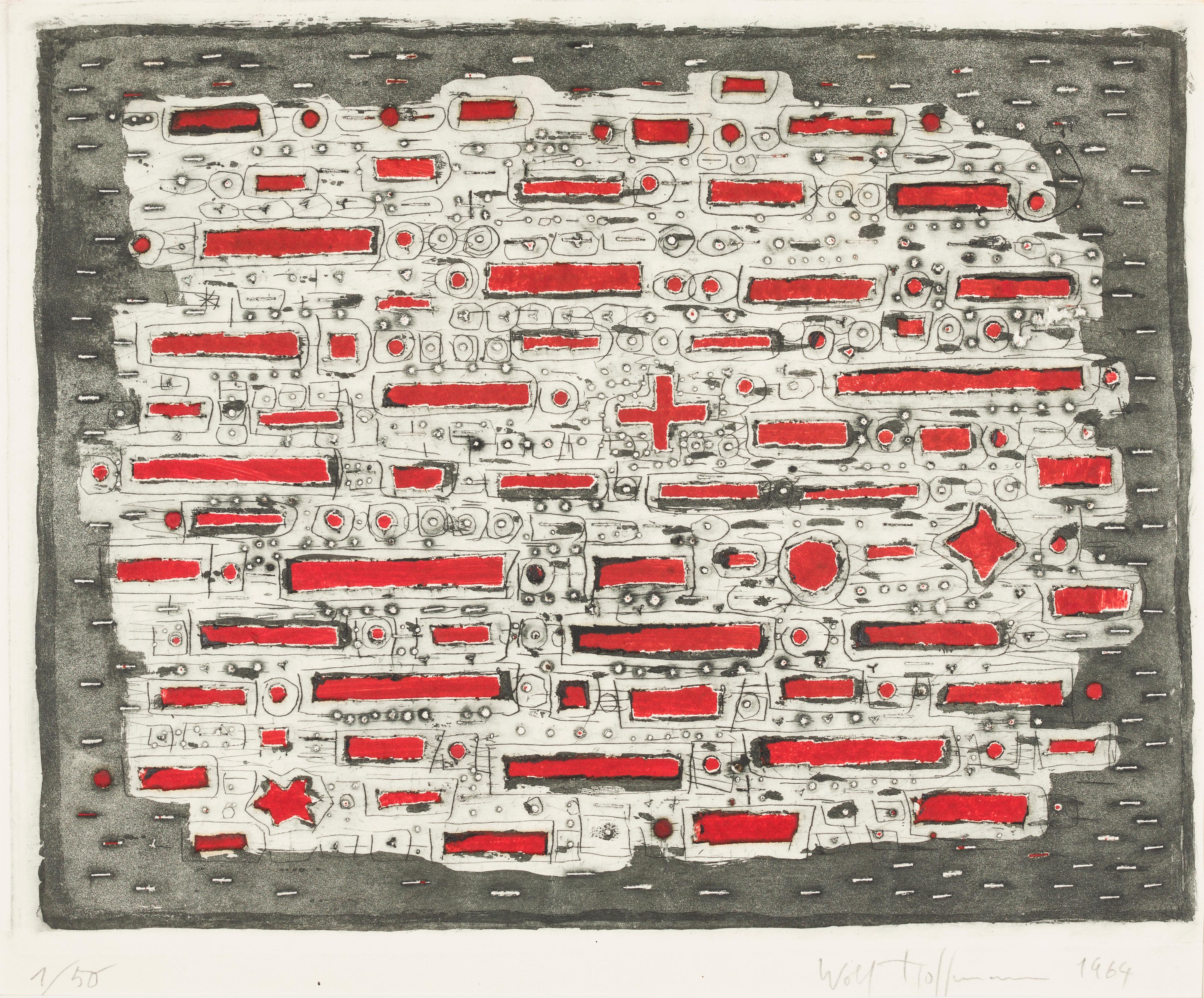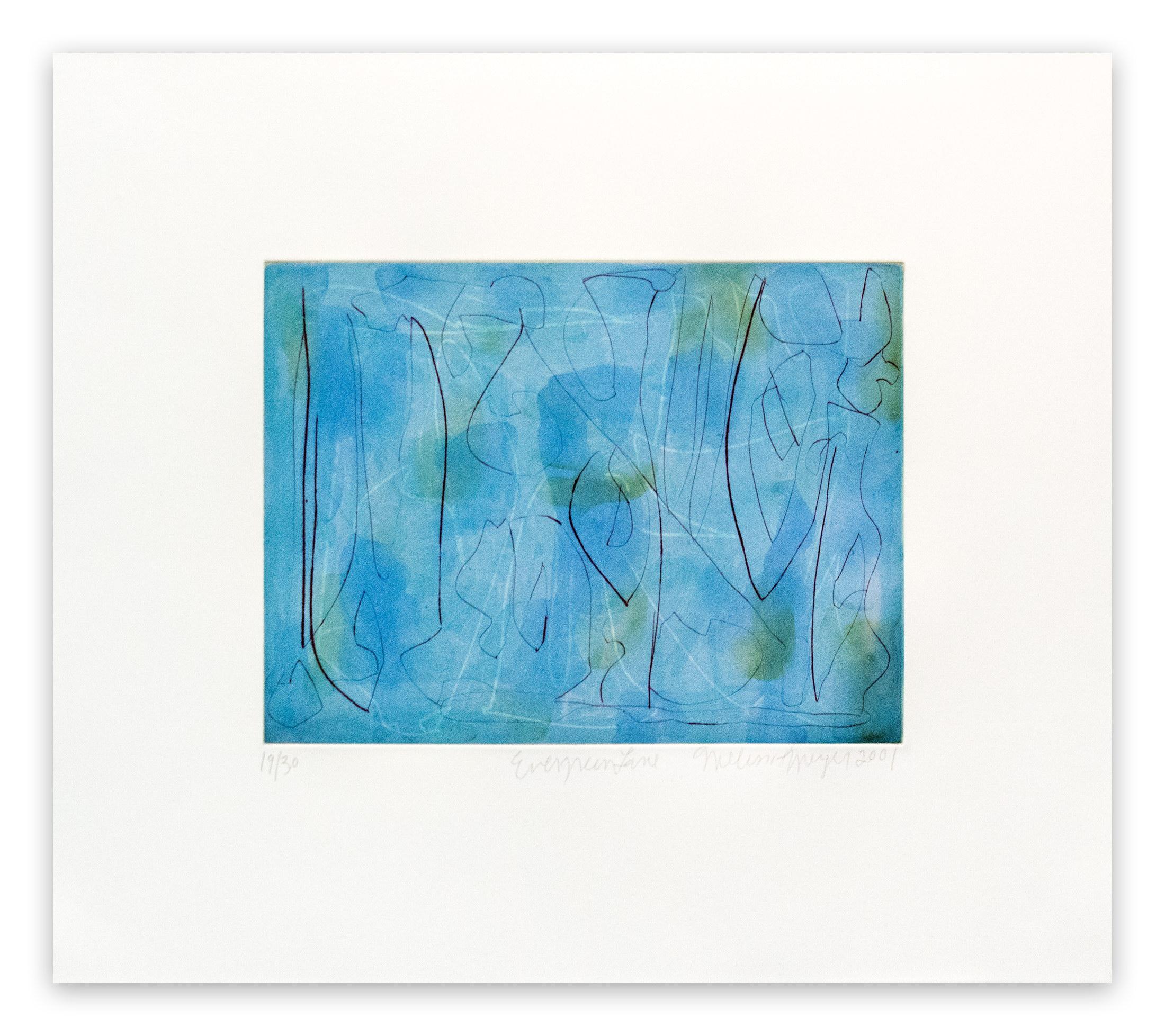Items Similar to Ornamental Composition
Want more images or videos?
Request additional images or videos from the seller
1 of 8
Wolf HoffmannOrnamental Composition
About the Item
“I have been living in Berlin as a painter for 45 years and since then a lot of water has flowed down the Spree, many ‘big’ and little names, many art scenes, a lot of noise and lots of hope have come along.
There was the great period of 1920-1933, when Berlin was a real and free art city, when the public still visited the exhibitions and the painters had not yet invented the publicity. There was the ’12th Reich’, which eliminated art. And there came the laborious new beginnings after 1945.
When I was a beginner, around 1925, I plunged rather carelessly into the lively art scene: first exhibition in the then very turbulent jury-free show. In 1927, for the first time, I succeeded in conquering a wall space in the academy on Pariser Platz, where Liebermann led a strict regiment. Many young exhibitions were organized and critically acclaimed (Paul Westheim). Paul Cassirer showed three generations in two beautiful exhibitions, I was one of the youngest. My first collective exhibition was in the Galerie Möller in 1928, after which I received a master studio in the ‘Akademie der Künste’ for three years. In the printing workshop on the Steinplatz I learned the etchings on the same press, on which I still create the plates at our university today. This was followed by further exhibitions, again at Möller in 1931, etchings in the gallery Gurlitt in 1932, in the Szczecin Museum, whose director Riezler acquired several pictures that were destroyed during the Nazi era. The Kronprinzenpalais had also bought a picture and the Kupferstichkabinett some etchings. Everything went ahead, and then, with one hit, it was over. In 1934, all free, progressive exhibitions were closed and the associations liquidated (Künstlerbund, Sezession). The end of painting. I learned ceramics and painted tiles and tiled stoves; The war also ended this escape, since I had to be a soldier for four years.
After the battle for Berlin, I crawled out of the rubble and saw the studio house in the Kurfürstenstraße along with the pictures, plates and everything burned down.
The life went on. The first art exhibition that Berlin organized in 1945 was a sign of recollection. The gallery Schüler, at that time in a Zehlendorfer garden villa, showed 1948 my first post-war pictures. 1949 Foundation of the ‘Neue Gruppe’. I started to etch again. Since 1950 I have been the head of the restored workshop for etching at the University of Fine Arts in Berlin and since 1951 a class for free graphics. Later, as a supplement, I introduced screen printing.
Since then it continues; Berlin has changed, different is also the art. Works are being produced in bigger numbers than ever, optimistic and alive. ”
Wolf Hoffmann
in: Gallery Gerda Bassenge, Wolf Hoffmann. Ölbilder, Farbradierungen, Aquarelle 1962/63, exh. Cat., Berlin 1964.
- Creator:Wolf Hoffmann (1898 - 1979)
- Dimensions:Height: 14.77 in (37.5 cm)Width: 12.6 in (32 cm)
- Medium:
- Movement & Style:
- Period:
- Condition:
- Gallery Location:Wien, AT
- Reference Number:1stDibs: LU1782210552522
About the Seller
No Reviews Yet
Vetted Seller
These experienced sellers undergo a comprehensive evaluation by our team of in-house experts.
Established in 1973
1stDibs seller since 2022
5 sales on 1stDibs
- ShippingRetrieving quote...Ships From: Wien, Austria
- Return PolicyA return for this item may be initiated within 7 days of delivery.
More From This SellerView All
- N°4 Star ScriptLocated in Wien, 9“I have been living in Berlin as a painter for 45 years and since then a lot of water has flowed down the Spree, many ‘big’ and little names, many art scenes, a lot of noise and lots of hope have come along. There was the great period of 1920-1933, when Berlin was a real and free art city, when the public still visited the exhibitions and the painters had not yet invented the publicity. There was the ’12th Reich’, which eliminated art. And there came the laborious new beginnings after 1945. When I was a beginner, around 1925, I plunged rather carelessly into the lively art scene: first exhibition in the then very turbulent jury-free show. In 1927, for the first time, I succeeded in conquering a wall space in the academy on Pariser Platz, where Liebermann led a strict regiment. Many young exhibitions were organized and critically acclaimed (Paul Westheim). Paul Cassirer showed three generations in two beautiful exhibitions, I was one of the youngest. My first collective exhibition was in the Galerie Möller in 1928, after which I received a master studio in the ‘Akademie der Künste’ for three years. In the printing workshop on the Steinplatz I learned the etchings on the same press, on which I still create the plates at our university today. This was followed by further exhibitions, again at Möller in 1931, etchings in the gallery Gurlitt in 1932, in the Szczecin Museum, whose director Riezler acquired several pictures that were destroyed during the Nazi era. The Kronprinzenpalais had also bought a picture and the Kupferstichkabinett some etchings. Everything went ahead, and then, with one hit, it was over. In 1934, all free, progressive exhibitions were closed and the associations liquidated (Künstlerbund, Sezession). The end of painting. I learned ceramics and painted tiles and tiled stoves; The war...Category
1960s Abstract Expressionist Abstract Drawings and Watercolors
MaterialsEtching, Lithograph
- The Mirror 3Located in Wien, 9“I have been living in Berlin as a painter for 45 years and since then a lot of water has flowed down the Spree, many ‘big’ and little names, many art scenes, a lot of noise and lots of hope have come along. There was the great period of 1920-1933, when Berlin was a real and free art city, when the public still visited the exhibitions and the painters had not yet invented the publicity. There was the ’12th Reich’, which eliminated art. And there came the laborious new beginnings after 1945. When I was a beginner, around 1925, I plunged rather carelessly into the lively art scene: first exhibition in the then very turbulent jury-free show. In 1927, for the first time, I succeeded in conquering a wall space in the academy on Pariser Platz, where Liebermann led a strict regiment. Many young exhibitions were organized and critically acclaimed (Paul Westheim). Paul Cassirer showed three generations in two beautiful exhibitions, I was one of the youngest. My first collective exhibition was in the Galerie Möller in 1928, after which I received a master studio in the ‘Akademie der Künste’ for three years. In the printing workshop on the Steinplatz I learned the etchings on the same press, on which I still create the plates at our university today. This was followed by further exhibitions, again at Möller in 1931, etchings in the gallery Gurlitt in 1932, in the Szczecin Museum, whose director Riezler acquired several pictures that were destroyed during the Nazi era. The Kronprinzenpalais had also bought a picture and the Kupferstichkabinett some etchings. Everything went ahead, and then, with one hit, it was over. In 1934, all free, progressive exhibitions were closed and the associations liquidated (Künstlerbund, Sezession). The end of painting. I learned ceramics and painted tiles and tiled stoves; The war...Category
1970s Abstract Expressionist Abstract Drawings and Watercolors
MaterialsLithograph
- NeedBy Hans StaudacherLocated in Wien, 9The artist has worked with various materials, but many of his works were created on paper. Although he began painting abstractly at an early age, Staudacher's roots lie in the figura...Category
20th Century Contemporary Abstract Drawings and Watercolors
MaterialsInk, Watercolor
- DaedalusBy Markus LüpertzLocated in Wien, 9Markus Lüpertz was born in Reichenberg in 1941 and works as a German painter, graphic artist and sculptor. He lives and works in Berlin, Karlsruhe, Düsseldorf and Florence and has hi...Category
21st Century and Contemporary Contemporary Abstract Drawings and Waterco...
MaterialsPaper, Mixed Media, Watercolor
- Composition 04By Hans StaudacherLocated in Wien, 9The artist has worked with various materials, but many of his works were created on paper. Although he began painting abstractly at an early age, Staudacher’s roots lie in the figura...Category
20th Century Contemporary Abstract Drawings and Watercolors
MaterialsInk, Watercolor, Pencil
- Chief accountingBy Hans StaudacherLocated in Wien, 9The artist has worked with various materials, but many of his works were created on paper. Although he began painting abstractly at an early age, Staudacher's roots lie in the figura...Category
20th Century Contemporary Abstract Drawings and Watercolors
MaterialsInk, Watercolor
You May Also Like
- Evergreen Lane (Abstract print)By Melissa MeyerLocated in London, GBEvergreen Lane (Abstract print) Etching - Unframed. This print is last in edition. This etching refers to a Steamboat Springs, Colorado street. It...Category
Early 2000s Abstract Expressionist Abstract Prints
MaterialsEtching
- Evergreen Lane (Abstract print)By Melissa MeyerLocated in London, GBEvergreen Lane (Abstract print) Etching - Unframed. This print is last in edition. This etching refers to a Steamboat Springs, Colorado street. It...Category
Early 2000s Abstract Expressionist Abstract Prints
MaterialsEtching
- Manuel Facal, Etching on paper, "Fondo V" (Original, 1985) Sunset, Yellow, GreenLocated in Carballo, ESEsta obra se trata de un grabado original del famoso artista Manuel Facal (A Coruña, 1943), perteneciente al grupo Atlantica, el grupo de artistas más fam...Category
20th Century Abstract Expressionist Landscape Drawings and Watercolors
MaterialsEtching, Paper
- Manuel Facal, Etching on paper, "Fondo VII" (Original, 1985)Located in Carballo, ESEsta obra se trata de un grabado original del famoso artista Manuel Facal (A Coruña, 1943), perteneciente al grupo Atlantica, el grupo de artistas mas fam...Category
20th Century Abstract Expressionist Abstract Paintings
MaterialsPaper, Etching
- Red Abstract AquatintBy Lilly McElroyLocated in Houston, TXBright abstract French aquatint in red tones by artist Lilly Elroy, titled "Hamed", 1990. Numbered 1/1 HC lower left. Signed and dated lower right. Original artwork on paper display...Category
1990s Abstract Abstract Drawings and Watercolors
MaterialsPaper, Aquatint
- An Interior Language IVLocated in New York, NYAbout the Series: Gilliam began the series Life Lines in 2017 after recently coming into possession of MRI scans of her brain. The scans, which she spent hours pouring over, both fas...Category
2010s Abstract Abstract Prints
MaterialsPhotographic Paper, Photogram, Etching, Aquatint
Recently Viewed
View AllMore Ways To Browse
Ornamental Vintage
Paul Berlin
Vintage Studio Tile
Vintage Wolf Art
Etched Pictures
Vintage Cat Head
Painting By Numbers Vintage
Recollection Vintage
Soldier Etching
Wolf Head
Vintage Wolf Painting
Aquatint 1920
Vintage Cat Picture
Paint By Numbers Vintage Art
Gerda With
A Hoffmann Painting
Aquarelle Vintage
Moller Painting


